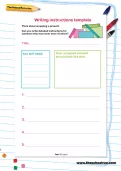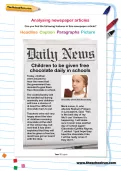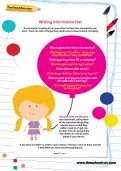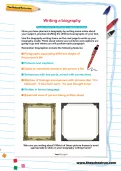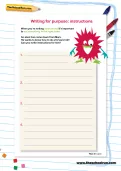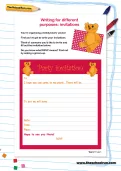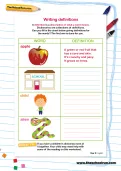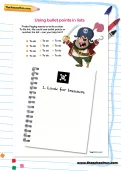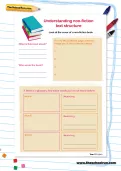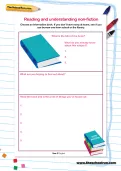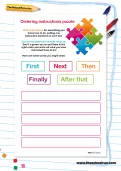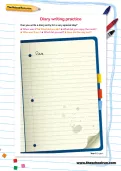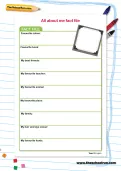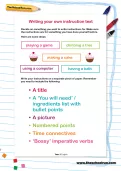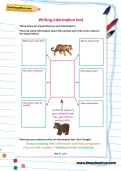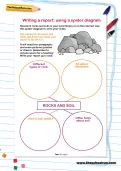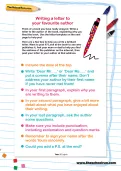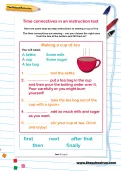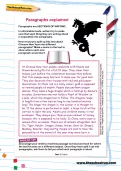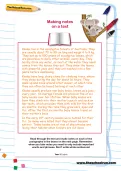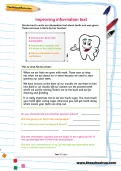When you’re writing instructions it’s important to put everything in the right order. An alien has come down from Mars. He wants to know how to do a forward roll! Can you write instructions for him?
or
Register to add to your saved resources
Already a subscriber? to view this content.
You’re organising a teddy bears’ picnic! First you’ve got to write your invitations. Think of someone you’d like to invite and fill out the invitation below. Do you know what RSVP means? Find out by asking a grown-up.
or
Register to add to your saved resources
A definition is a description of what a word means. Dictionaries are collections of definitions. Can you fill in the chart giving definitions for the words? The first one is done for you.
or
Register to add to your saved resources
Already a subscriber? to view this content.
News is out that aliens have landed! Write a news report explaining all the facts – and don’t forget to draw and caption a picture so your readers know what the aliens look like!
or
Register to add to your saved resources
Already a subscriber? to view this content.
Pirate Pegleg wants to write a clear To Do list. He could use bullet points or number his list – can you help him?
or
Register to add to your saved resources
Look at the cover of a non-fiction book. What is the book about? Turn to the contents page. List four things you’d like to find out about. If there is a glossary, find some words you’ve not heard before.
or
Register to add to your saved resources
Already a subscriber? to view this content.
Read these titles and words. Cut them out and put them in two piles, one for things you think belong in a fiction book and one for non-fiction. Ask your mum or dad for help with reading the sentences if you need to.
or
Register to add to your saved resources
Already a subscriber? to view this content.
Choose an information book. If you don’t have many at home, see if you can borrow one from school or the library. What is the title of the book? What are you hoping to find out about? What do you already know about this subject? Read the book and write a list of things you’ve found out:
or
Register to add to your saved resources
Already a subscriber? to view this content.
Write instructions for something you know how to do, putting one instruction sentence in each box. Cut out the boxes and muddle them up. See if a grown-up can put them in the right order and work out what you have instructed them to do! Here are some words you might need: first; next; then; finally; after that.
or
Register to add to your saved resources
Already a subscriber? to view this content.
Can you write a diary entry for a very special day? When was it? What did you do? What did you enjoy the most? Who was there? What did you eat? How did the day end?
or
Register to add to your saved resources
Already a subscriber? to view this content.
Fill in this fact file all about yourself. What is your favourite colour? Your favourite book? Who are your best friends? Your favourite teacher? This is the place to put all those really important facts.
or
Register to add to your saved resources
Already a subscriber? to view this content.
Decide on something you want to write instructions for. Make sure the instructions are for something you have done yourself before. Write your instructions on a separate piece of paper. Remember
you need to include the following: • A title • A ‘You will need’ / ingredients list with bullet points • A picture • Numbered points • Time connectives • ‘Bossy’ imperative verbs
or
Register to add to your saved resources
Already a subscriber? to view this content.
Think about wrapping a present. Can you write detailed instructions for someone who has never done it before? Think about what you will need and what your wrapped present should look like.
or
Register to add to your saved resources
Think about an animal that you are interested in. Find out some information about this animal and write some notes in the boxes below. Now use your notes to write an information text. Don’t forget: An eye-catching title; information split into paragraphs; pictures with captions; sentences with connectives.
or
Register to add to your saved resources
Already a subscriber? to view this content.
Research rocks and soils in your local library or on the internet. Use this spider diagram to write your notes. Get a sheet of A4 paper and think about how you want your report to be set out. It will need four paragraphs and some pictures (printed or drawn). Remember to include space for a heading! Write your report up in neat.
or
Register to add to your saved resources
Already a subscriber? to view this content.
Think of a book you have really enjoyed. Write a letter to the author of the book, explaining why you liked the book. Use this letter template to help you! You could send them the letter if you like.
or
Register to add to your saved resources
Already a subscriber? to view this content.
Help your primary-school child practise using time connectives in an instruction text with this teacher-created KS2 worksheet.
Here are some step-by-step instructions to making a cup of tea. The time connectives are missing – can you choose the right ones from the box at the bottom and fill them in?
or
Register to add to your saved resources
Already a subscriber? to view this content.
Paragraphs are sections of writing. In information texts, writers try to make sure that each thing they are writing about is separated into paragraphs. How would you split up this text about Chinese New Year into different paragraphs? Make a mark on the text to show where each new paragraph would start.
or
Register to add to your saved resources
Already a subscriber? to view this content.
Read through the text and make notes on each of the paragraphs in the boxes on the next page. Remember: when you take notes you need to only include important words and phrases. Don’t write whole sentences!
or
Register to add to your saved resources
Already a subscriber? to view this content.
Nicola had to write an information text about teeth and was given these success criteria by her teacher: Group your facts into paragraphs; remember capitals and full stops in the right places; use connectives in your sentences. Did Nicola do what the teacher asked?
or
Register to add to your saved resources
Already a subscriber? to view this content.
